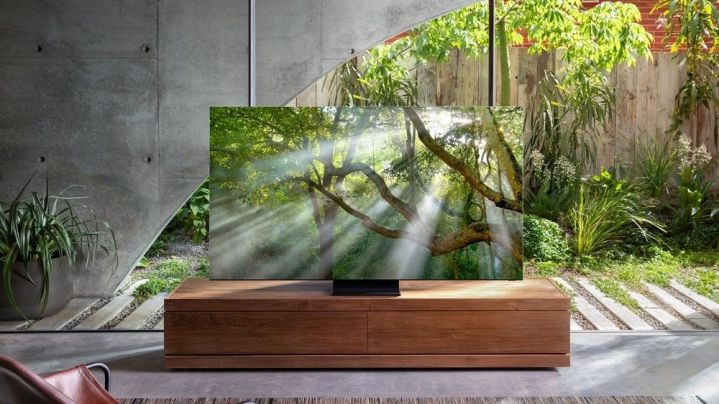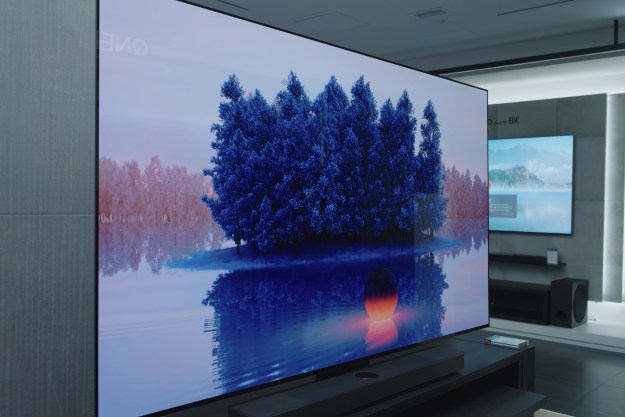2020 is going to be an awesome year for TVs. I’m more excited to review what’s coming than I have been in quite some time, and that’s really saying something. Also, for the first time in a decade, I’m comfortable predicting which makes and models I think will be the best TVs this year. Of course, there can always be surprises, but these are the best bets based on what I saw at CES2020.
I was surprised that CES was very different for TVs this year. Sure, we saw plenty of those pie-in-the-sky concept TVs, like Samsung’s ridiculous (in the best way) 292-inch Wall TV, but more of this year’s TVs than ever before were not only TVs you may actually buy, they also look to redefine the industry.
LG’s 48-inch CX OLED
Sure, LG’s roll-up and roll-down OLEDs got lots of headlines and TV coverage, but it’s the new CX (read: C-10) OLED that I think is the more groundbreaking TV.
At 48-inches, this TV does more to blur the line between TVs and gaming monitors than anything we’ve seen before. It will fit on your desktop, it’s got all of the essential gaming-monitor features – low input lag, variable refresh rate (VRR), high frame rate – while also giving us the amazing picture quality that comes from a TV with a dedicated picture processor. And the HDR is legitimately impressive too.

Other than ultra-high refresh rates and 21:9 aspect ratio, I don’t know why you would spend twice as much on an ultra-premium gaming monitor when this gorgeous TV is going to serve just about every display most folks might have.
Also a shoutout to LG’s gallery series (A.K.A G-Series) OLEDs which, from a design perspective, look really attractive. Much of the appeal we’ve seen from the LG W-Series Wallpaper OLED is here, but without the big soundbar.
Samsung Q950TS
This is a TV you have to see to believe. The Samsung Q950TS is a feat of TV engineering. It’s only 15mm thick — which has it treading firmly into OLED territory on the thinness front – and I honestly don’t know how they did it. How is this a full-array local dimming LED TV?

Aside from its trim form, the Q950TS also has practically no bezel, and with no black matrix around the edge, the screen is 99% image. I find it has a mesmerizing effect that must be seen to understand. When wall-mounted, it is a perfectly uniform plate on the wall with no discernible edge. It’s a design that I really dig.
Oh, and did I mention it’s an 8K QLED?
TCL mini-LED 6-Series TV
TCL is crushing it right now. It was first brand to bring a mini-LED tech to the market with its premium 8-Series last year, and it is not hoarding that technology for just its top tier TVs in 2020.
Believe it or not, the vaunted 6-series will be getting mini-LED technology in 2020. That’s the fastest tech trickledown I think I’ve ever seen.
This move puts a remarkable amount of pressure on other manufacturers who only have mini-LED in their prototype stages right now. LG had a prototype, and so did Vizio, but here TCL is going into only its second generation of mini-LED and it’s already spreading the love down what we can expect to be an affordable level.
TCL Vidrian
If mini-LED in its 6-Series isn’t groundbreaking enough, consider that TCL has already figured out how to juice mini-LED up to the next level. TCL calls this new mini-LED approach Vidrian, and while I don’t know if this is going to be in a new 8-series TV or if it will get a different name entirely, I don’t think it really matters.

TCL assures me Vidrian is going to be in a TV in 2020 and it will be brighter, more colorful, and closer to OLED than anything we’ve seen from an LCD-based TV before.
Vizio OLED
The reason an OLED from Vizio is so important is that it new OLED TVs from brands like Konka and Philips, bringing some serious competition to LG and Sony. When brands compete, consumers win, and that means more affordable OLEDs across the board.
I expect the Vizio OLED to stand right up next to LG, Sony, and Philips in terms of picture quality, but the price will be lower. This means we have a good, better, best situation in OLED, with Vizio making the most sense for a huge customer base.
We don’t know what the model name or number will be yet, so for now, it’s just Vizio OLED.
Vizio P Series Quantum X
What Vizio is doing to the OLED market, it is also doing to the premium LCD segment. The P Series Quantum X is posed to offer the highest brightness and the most local dimming zones found in any TV in 2020, and that’s going to put a lot of pressure on Samsung and Sony.
Again, Vizio is bringing some much-needed competition in the space, and its new picture processor – which has been in development for 4 years now – looks extremely promising. Also, Vizio’s SmartCast system appears to work much better than it has in prior years.
If Vizio closes the gap in performance between it and its rivals, its value proposition might be unstoppable.
Where’s Sony in all this?
Why is there no Sony TV on this list? Well, because while Sony made some cool design changes and brought its X1 Ultimate chip to less expensive models, the new TVs it showed at CES are slight alterations on last year’s TVs. That isn’t to say they aren’t gorgeous — because they are — but they aren’t market-shifting TVs.
One key missing feature seems to be HDMI 2.1 across Sony’s TV lineup. Every TV on this list offers full-spec HDMI 2.1, which I think goes a long way to future-proofing a TV.
Now, if the new A9S – that’ll be Sony’s version of LG’s 48-inch OLED – were on the show floor, that would be something else. But that TV, as far as I can tell, is still under development.
When will we get these new TVs?
Historically, new TVs start trickling in around late April through May. By the end of June, most should be on store shelves. I’m going to push that further out for the Vidrian, though, which will likely be brought to market toward the end of 2020.
Until then, start saving your pennies!
Editors' Recommendations
- The 10 most popular streaming services, ranked by subscriber count
- New $129 Moto Buds+ tap Bose for boom and Dolby for head tracking
- Samsung’s new 98-inch DU9000 4K TV is just $4,000. Can it beat TCL and Hisense?
- Roku Pro Series TVs finally go after the high(er) end, start at $899
- Spotify’s new AI Playlist feature uses text prompts to curate playlists




